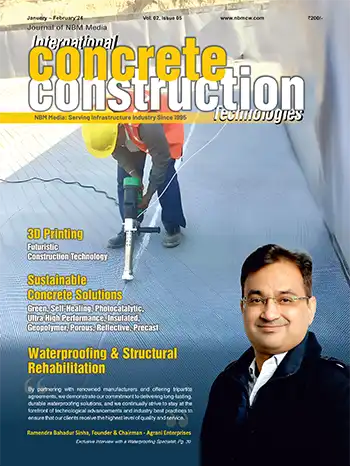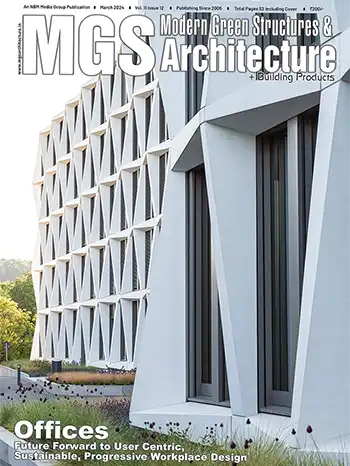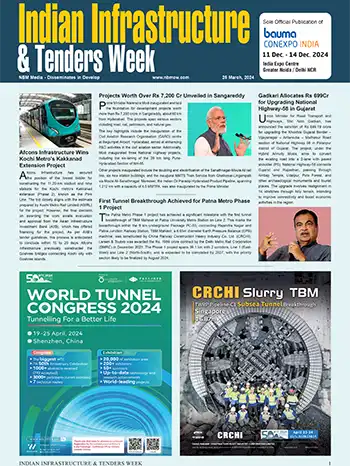Web-enabled Management of Construction Projects
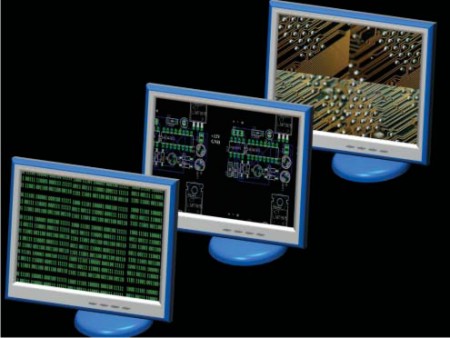
V. Thiruvengadam, Professor, Building Engineering and Management, and Vanita Ahuja, School of Planning and Architecture, New Delhi.
Internet
Internet is a global network and with its open standards and accessibility, it is fast evolving into a powerful environment for supporting distributed group work. It has also embraces the construction industry so that it could be used as an efficient tool for communication to bring together the widely dispersed project participants and multinational project teams. For working on internet, web browser is the user interface and the web server helps in storage and retrieval of information.Construction project team members can use internet to do the following:
- Communicate in real time, with others connected to the internet.
- Exchange information through emails.
- Send or receive text, sound, animation, and picture files all over the world.
- Browse through resources of private or public information services that are connected through the internet.
- Join specific topic oriented discussion groups.
- Search for, retrieve and read files stored on computers throughout the world.
- Send and receive programme data files as spreadsheets, CAD files etc.
- Sell and purchase products and services online (e-commerce).
- Set up a site with information about the company's products, services or projects.
- Distribute electronic publications.
World Wide Web (www)
World Wide Web is basically a concept for hypertext organising of information objects in an internet environment. The basis is a set of communication protocols and a standard for hypertext documents prepared using HTML (Hypertext Mark up Language) originally made for sharing of information in heterogeneous environments. The web in itself is an interesting phenomenon. Information published in HTML is easily accessible by any one with a computer and an internet connection and all major software vendors are striving to implement web functionality into their products.Project Collaborative Extranets
An extranet is basically a network linking a number of different organisations for the exchange of information. It stores all project documents and drawings on an internet accessed, password protected, dedicated website, where all team members from client to designer to contractor can access the most up-to-date project information at any time and from anywhere in the world. It can be accessed in three ways – (i) via internet with a web browser, (ii) via private network, and (iii) Direct communication between two computers via telephone line.Suggested web environment for a construction management organisation:
- Every organisation should have and use an internal (and preferably an external) website that becomes the hub for corporate information exchange and dissemination.
- A process manager has the authority to manage the website.
- Every department/engineering group has its own web server for engineering specific information. This server is linked to and indexed by the corporate website with as open an access policy as possible. All non-project specific engineering and architectural departmental information is maintained here.
- Project managers of different projects are authorised to create the project website and database for each new architecture/ engineering project and issue request and authorisation to the project participants to access and use the project data.
- Each project website is linked to relevant existing and past projects.
- All the project specific information (for example project master schedules, meeting notes, progress reports, vendor links, contract requirements, regulatory requirements, specification documents and drawing files) is accessed from the project website.
- Users can login to the site through standard access control mechanisms i.e., password protection, certificates etc. Controlled access to appropriate subsets of the site can be given.
- Data access is handled through menus on the web pages. Each menu item issues a command to a web server. The web server then delegates the responsibility to a dedicated web application interface (WAI) to act on the request by accessing the project database and displaying the results on a web browser, planning applications, spreadsheets, etc.
Web Based Applications for Construction Projects
Web Based Information Systems
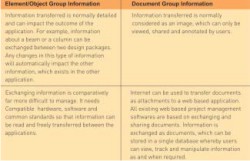
Project team members access various information bases during the course of the project for effective decision making. Some such information bases are shown in Figure. 1.
Project specific information would be available on the corporate website and project website. External information is available on some external webbases. These bases contain information structured in a standard format specific to their domain. Value added service providers (VASP) maintain these bases. These could be manufacturers of products, standardisation institutions, universities, private bodies, etc. Figure. 2 shows the system architecture of a web based information system based on suggested web environment.
Figure. 3 shows the system architecture of the project website in detail.
Web Based Applications for Document Based Data Exchange
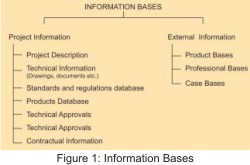
Tender stage
Web enabled softwares used in this stage are useful for the following:
- Speed up the distribution of documentation and tenders communications.
- Register tenderers online and download tender documents electronically.
- Provide a simple environment to evaluate the tenderers responses through standard templates.
- Prevent unauthorised access through built-in security mechanisms.
- Communicate changes in the tender documents during the tender process quickly and easily.
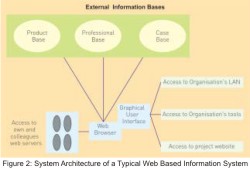
- Reduce the risk of errors and rework by ensuring that everyone in the project team is working with the most current drawings and other documents.
- Save time in the query (request for information, RFI) and approval process by allowing the design team to mark up and comment on drawings alone.
- Eliminate the risk of losing important files by maintaining all current and past versions in one central location.
- Improve team communication by enabling team members to raise and respond to queries in a structured way.
- Maintain a complete log of all communications for tracking purposes (Audit Trail Facility).
- Provide clients and other participants with a view of the project as it is built as some software have incorporated virtual reality models to denote the status of a project at any point in time (a snapshot view of the project).
- Provide a collaborative environment whereby the diverse participants can prefer online collaboration via the web.
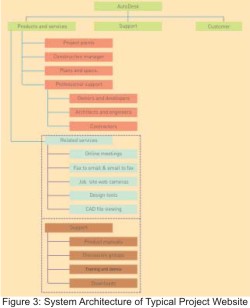
Web enabled softwares used in this stage are useful for the following:
- Save time in the procurement of materials by automating document distribution and communications (e-procurement / e-commerce).
- Reduce the administration costs of document handling and distribution to multiple parties.
- Reduce errors due to effective communication.
- Ensure ease of comparison and evaluation of bids.
Total Information Transfer System (TOTINS)
The objective of TOTINS is to help information transfer more effectively during the construction process between head office and its far off construction sites (Deng et al, 2000).System Description
- TOTINS uses Linux (Unix based) and MS Windows 95 (PC based) for setting up the information transfer system.
- Logging to the remote host is achieved through telnet and transfer of files through file transfer protocol (FTP). This function enables file transfer from one computer to another irrespective of their operating systems.
- Telnet protocol allows the internet user to log into a remote host from the local host computer. Due to its direct connection to the remote system, the system can provide a less costly and efficient method to get information compared to fax, phone or post.
- Security of the server information is provided through password access.
- Email and internet chat is enhanced with on-screen images, pictures or drawings. It can simulate telephone conservations and meetings.
Web Enabled Project Management Software
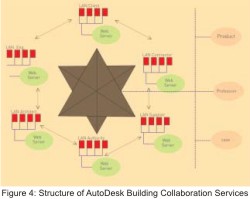
AutoDesk
AutoDesk Building Collaboration Services (formerly Buzzsaw.com) comprises online project collaboration and print management solutions that connect project teams for better communication throughout the building process–design, construction and facility management.Related collaborative services
AutoDesk is affiliated with technology leaders in related areas to enhance the use of the applications and provide a complete service for building professionals. The following related collaborative services are available on the portal: (i) Online meetings, (ii) Fax to email and email to fax, (iii) Job site web camera, (iv) Design tools, and (v) CAD/file viewing.
An automated site photography camera can be set up that takes high-resolution digital photographs at the user's construction site and publishes them to the internet. To receive a digital camera, a controller, and a monthly service that provides images accessible from the web, the users have to first sign up for the service.
A project web camera helps as follows.
- Share progress with those in remote locations.
- Resolve issues and questions remotely using live site photos.
- Minimize site visits by monitoring construction from the office.
- Improve job site security by photographing the entrance.
Case Study
3D/International Inc, a leading US based design and construction management firm used AutoDesk for completing the master plan and design phase of a ten million dollar development project for Automotive Systems Group of Jhonson Control Inc in Reynosa, Mexico (source: http://usa.autodesk.com).The project was divided into three phases. The biggest challenge to the project was that all of the final engineering – civil, structural, mechanical, electrical, plumbing and compressed air – was completed in Reynosa, Mexico, while all the architectural work and technical conceptualization was completed in San Antonio, Texas. Using AutoDesk online collaboration tool, 3D/I was able to overcome these geographical obstacles.
A member of the 3D/I project team was authorized to set up an account on AutoDesk's project workspace. The entire team was online and everyone's role-based access rules were established. At project site also a PC was installed in a trailer. Through the use of AutoDesk's web based project collaboration tools, 3D/I's team of contractors, architects, engineers, consultants and suppliers were able to share project documents, communicate and collaborate in real-time to save time and provide extraordinary value to their clients. This streamlined process enabled 3D/I to gather approvals from project site managers and even government agencies while working in tandem with the construction process.
The design phase of the project was completed in four months, resulting in an estimated savings to the building owner and project teams on production costs. Normally, the design phase of a project of this size could take as much as eight months. Creating computer aided design (CAD) drawings for the first phase of the project, the 3D/I and team were able to (i) communicate via email on revisions, and (ii) eliminate the expensive printing and overnight shipment of documents. These facilities delivered immediate value to the building owner. These were ease of use for users who not only had limited computer experience, but potential language barriers. AutoDesk's online collaboration helped to complete a project of enormous size and scope on schedule and within budget. According to the client, AutoDesk was an instrumental tool that helped to successfully manage a project that included more than 50 people located across the United States and Mexico.
E-commerce
E-commerce is a term for conducting business transactions through the web. It could be transaction of products or services and it is going to be the most flourishing business in the world in the next few development decades. The types of e-commerce can be listed as (i) Business to consumer (B2C), (ii) Business to business (B2B), (iii) Consumer to business (C2B), and (iv) Consumer to consumer (C2C). Many legal issues come up as the distances and hierarchies disappear and inter country business is conducted from remote locations and remote sites. E-commerce requires acceptance and legal recognition of records in electronic form and digital signatures. The government of India has introduced an Information Technology Bill (1999) approved by the Cabinet on 14 May 2000 which seeks to provide legal recognition to electronic records and digital signatures and provides for a regulatory regime for supervision and implementation (RITES Report). The electronic transactions themselves have to be effectively secured in respect of confidentiality, integrity, authenticity, non-repudiability and auditability.Benefits of Web Enabled Construction Project Management
All construction project managers could benefit through web enabled project management due to the following:- Ability to provide an instant snapshot of the status of all projects.
- Capability to promote a consistent or standardised format for sharing project information or files throughout the entire project.
- Ability to provide a platform for effective information exchange and coordination between all agencies involved in the project.
- Ability to provide a platform for effective transactions or e-commerce, which is a part of project management.
- Ability for better tracking and managing of project documents, measuring progress and easily setting roles and responsibilities for the team members.
- Cost saving ability. Cost of providing and maintaining internet to construction sites costs less as compared to telephone communication and courier service.
- Influence on improving measures of business performance. Various business models have been evolved, which draw upon links between the use of internet to perform project management and to improve an organisation's internal processes in their road to achieve excellence.
In order to successfully embrace web enabled project management tools in large scale, the following issues need to be addressed:
- Construction industry must give equal importance to technology, process, people, procurement, legal issues and knowledge management.
- The efficiency of current processes must be carefully addressed and re-engineered to take advantage of the latest advances in technology.
- The industry should work towards minimum common standards to facilitate the flow of information across the supply chain so that the exchanged information is fully integrated with business processes.
- People must have necessary skills and the rewarding environment to harness the benefits of the internet.
- Document based exchange tools should be taken forward to provide integrated databases at the element/object level.
- ‘True application integration' needs to be achieved so that same data can be read across all applications in real time. For example, the data that goes into an accounting package should able be to read by an estimation package and a project management package automatically with no human intervention. This also ensures that the data stays up-to-date, accurate and available for the very next request.
- Security of project information is a major issue, which needs to be addressed for any online collaboration between project and team members.
Conclusions
The communications technology rapidly advances in utilizing internet and web based networks for interconnecting sites and companies using relatively inexpensive personal computers, which are now available at every site. The impact of successful, widespread adoption of advanced communication technologies in the construction industry could be very significant. The increasing accessibility and affordability of communication technologies could pave way for the emergence of globally based virtual organisations operating in knowledge driven markets from geographically remote locations.The impact of this knowledge revolution on the construction industry so far appears to have been quite superficial, but there are potentially deeper and more pervasive changes, which the new technologies may prompt within the construction industry itself, the implications of which are likely to be multifaceted and probably irreversible.
References
- Alshawi Mustaffa, Ingrige Bingunath. 2002: Web Based Project Management, www.construct-it.org.uk
- Bower D J., Hinks J., Wright H., Hardcastle C., Cuckow H. 2001: ICTs, Videoconferencing and the Construction Industry – Opportunity or Threat?, Construction Innovation, Vol. 1, No. 2, pp 129-144.
- Deng Z M., Li H., Tam C M., Shen Q P., Love P E D. 2001: An Application of the Internet Based Project Management System, Automation in Construction, Vol. 10, Elsevier, pp 239-246.
- Gupta Atul. 2000: Information Technology and Integration of Construction Process, Masters Seminar, School of Planning and Architecture, New Delhi. http://usa.autodesk.com
- Kamble Alpana. 2002: Project Coordination and Collaboration Using IT, Masters Seminar, School of Planning and Architecture, New Delhi.
- RITES. 2000: Web-Site Consultancy and E-commerce, A RITES Report, New Delhi.
NBM&CW August 2007















